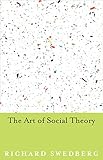The Art of Social Theory / Richard Swedberg.
Material type: TextPublisher: Princeton, NJ : Princeton University Press, [2014]Copyright date: ©2014Edition: Course BookDescription: 1 online resource (288 p.) : 1 line illus. 1 tableContent type:
TextPublisher: Princeton, NJ : Princeton University Press, [2014]Copyright date: ©2014Edition: Course BookDescription: 1 online resource (288 p.) : 1 line illus. 1 tableContent type: - 9780691155227
- 9781400850358
- Sociology -- Methodology
- SOCIAL SCIENCE / Sociology / General
- Archimedes
- Charles S. Peirce
- William Whewell
- abduction
- analogies
- analogon
- analogy
- art
- classification
- cognitive science
- colligation
- concept
- creative theorizing
- creative work
- creativity
- diagrams
- discovery
- empirical material
- explanation
- guessing
- heuristic stance
- heuristics
- hypothesis
- imagination
- justification
- knowledge
- metaphor
- metaphors
- naming
- observation
- pattern recognition
- patterns
- practical exercises
- preliminary data
- reasoning
- research process
- researcher
- retroduction
- scientific analysis
- scientific research
- social data
- social life
- social science
- social scientists
- social theory
- theoretical imagination
- theorizing
- theory
- thinking
- typology
- 301 23
- HM585 .S94 2017
- online - DeGruyter
- Issued also in print.
| Item type | Current library | Call number | URL | Status | Notes | Barcode | |
|---|---|---|---|---|---|---|---|
 eBook
eBook
|
Biblioteca "Angelicum" Pont. Univ. S.Tommaso d'Aquino Nuvola online | online - DeGruyter (Browse shelf(Opens below)) | Online access | Not for loan (Accesso limitato) | Accesso per gli utenti autorizzati / Access for authorized users | (dgr)9781400850358 |
Frontmatter -- Contents -- Introduction: Why Theorize and Can You Learn to Do It? -- Part 1: How to Theorize -- Chapter 1. Starting Anew -- Chapter 2. Social Observation -- Chapter 3. Naming, Concept, and Typology -- Chapter 4. Analogy, Metaphor, and Pattern -- Chapter 5. Coming Up with an Explanation -- Part 2: Preparing for Theorizing -- Chapter 6. Heuristics -- Chapter 7. Practical Exercises -- Chapter 8. The Role of Theory -- Chapter 9. Imagination and Art -- Chapter 10. Summary and More -- Appendix: How to Theorize according to Charles S. Peirce -- Acknowledgments -- Notes -- References -- Index
restricted access online access with authorization star
http://purl.org/coar/access_right/c_16ec
In the social sciences today, students are taught theory by reading and analyzing the works of Karl Marx, Max Weber, and other foundational figures of the discipline. What they rarely learn, however, is how to actually theorize. The Art of Social Theory is a practical guide to doing just that.In this one-of-a-kind user's manual for social theorists, Richard Swedberg explains how theorizing occurs in what he calls the context of discovery, a process in which the researcher gathers preliminary data and thinks creatively about it using tools such as metaphor, analogy, and typology. He guides readers through each step of the theorist's art, from observation and naming to concept formation and explanation. To theorize well, you also need a sound knowledge of existing social theory. Swedberg introduces readers to the most important theories and concepts, and discusses how to go about mastering them. If you can think, you can also learn to theorize. This book shows you how.Concise and accessible, The Art of Social Theory features helpful examples throughout, and also provides practical exercises that enable readers to learn through doing.
Issued also in print.
Mode of access: Internet via World Wide Web.
In English.
Description based on online resource; title from PDF title page (publisher's Web site, viewed 29. Jul 2021)


